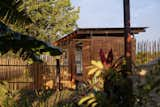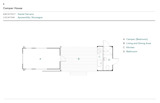This Surfer Road Tripped to Nicaragua, Built an $8K Tiny Home, and Decided to Never Leave
"None of this was part of my plan," says architect Dani Serrano of creating a home out of the Pastime Camper he bought for $1,500 in 2019. A passionate surfer and traveler, Dani only knew one thing when he started out on the Pan-American Highway in Oregon: that he was taking four months off from work to drive down the Pacific Coast toward South America in search of the perfect wave. In Aposentillo, Nicaragua, he found a break that fit the bill, a legendary spot known as The Boom. But he also discovered a hospitable climate, a strong community, and a low-cost lifestyle.
"I was also intrigued by the potential that my architecture could have in a remote place like this," he adds. Wasting no time, he promptly bought a half acre covered with fruit trees, fixed the detached camper on it, and began designing beachfront homes and resort properties for clients in the area.
Four months on the road in his camper made Dani a devotee of essentials-only living, and temperate Nicaragua made it easy to keep that up. But with occasional wet weather, he decided to experiment by building a traditional palm palapa as a shelter for the camper. "I really wanted to build a roof similar to a classic hut," he says. "And I needed a temporary roof to keep the camper dry during the rainy season."
Dani never imagined sticking around for long—"at first my plan was just to enjoy life in this place and use the caravan as a refuge," he says—but with plenty of interesting architectural projects, ample waves, and a simple, outdoor-oriented lifestyle, he decided Nicaragua would make a pretty good outpost when he wasn’t back home in San Sebastian, Spain. The camper was going to need some upgrades.
In line with his less-is-more mentality, Dani knew he wanted his new setup to be compact, as sustainable as possible, and inexpensive to operate. To meet those ends he relied on locally-sourced materials, like teak wood provided by friends in the area, and metal joints made by a local welder. "I bought the rest of the materials from a hardware store in the closest city, Chinandega," he explains. "Everything is very basic."
Using tools equally as simple—a radial arm saw and a drill—Dani and his friend, Tiemo Riediger, a carpenter, put the camper on stilts, turned it into a dedicated bedroom, and built an open-air wooden frame around it to add living space, a kitchen, and a bathroom. To stabilize the camper, they secured the stilts in a small concrete slab base, and then bolted the camper onto the stilts. The camper slots perfectly into place in the structure, just as it did on Dani’s truck.
At the opposite end of the structure, Dani built the bath using smooth teak paired with modern white appliances and black fittings for a spa-like feel that contrasts with the camper’s rustic functionality. A slightly pitched, corrugated steel roof tops the wooden frame, providing protection from rain without sealing the home off from fresh air and light. With no immediate neighbors, privacy wasn’t a concern, and Dani opted for a central dining/living area that could be fully opened to the garden.
For the front of the living space, Dani and Tiemo constructed a teak and fabric partition that slides along a track. For window coverings at the rear, he used simple wood panels that operate with ropes and pulleys. "They’re easy to operate and make you feel as if you’re living on a sailboat, with the wind often dictating whether to crank them open or closed," he says. "If the weather is good, there is no problem in leaving it open day and night." When closed up after dark, the house is lit with hanging paper lanterns; from the outside, it appears to glow like a lantern itself.
To establish a boundary for his property and enhance the sense of privacy and place, Dani built a primitive but striking fence at its entrance. He used thin, rustic teak rods arranged vertically along horizontal planks. "It allows silhouettes to be intuited," he explains, "but you can’t see through it clearly." The fence, however modest, adds a decorative touch to the utilitarian appearance of the camper’s structure.
Relying on local materials and doing the construction himself kept project costs to a minimum. Dani estimates he spent about $8,000 all in, including the camper, tools, purchasing and transporting materials, building a small storage unit to house the tools, and cookware for the kitchen. Part of its beauty is that, similar to the camper’s spirit, the structure is designed to be impermanent; it can be easily disassembled, moved, set up elsewhere, or recycled. "I definitely think the simple construction is one of the main characteristics of this project," says Dani.
Not only were the construction costs low, the project has been slowly paying for itself. When Dani’s on the road or back in Spain, he rents his home out on Airbnb. And for the six months each year he spends in Nicaragua, Dani uses his home as an "office" where he works and meets with clients. Of course, he finds plenty of time to do the things that kept him around in the first place. "I read books in the hammock on the terrace, do sunrise yoga, and eat well," he says. "And score epic waves."
More Campers and Trailers:
An Ecuador Couple Seek Out Adventure in a DIY Tiny Cabin on Wheels
A Family of Four Lives Large in a Renovated Skoolie Named the Butter Bus
Project Credits:
Architect: Dani Serrano Studio / @daniserra.f
Builders: Dani Serrano & Tiemo Riediger
Photography: Dani Serrano Studio
Published
Stay up to Date on the Latest in Tiny Homes
Discover small spaces filled with big ideas—from clever storage solutions to shape-shifting rooms.



























